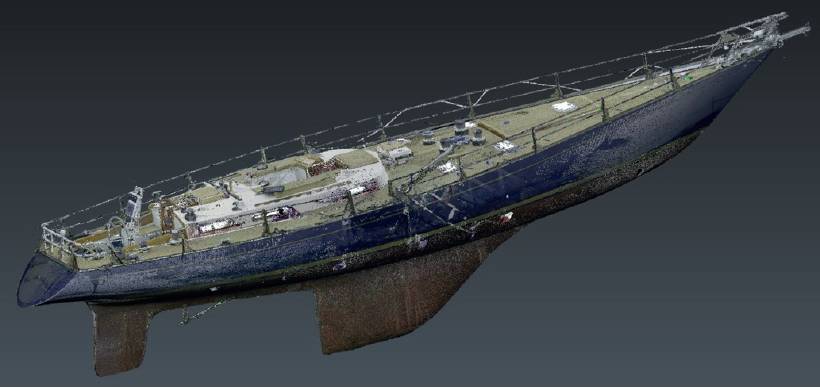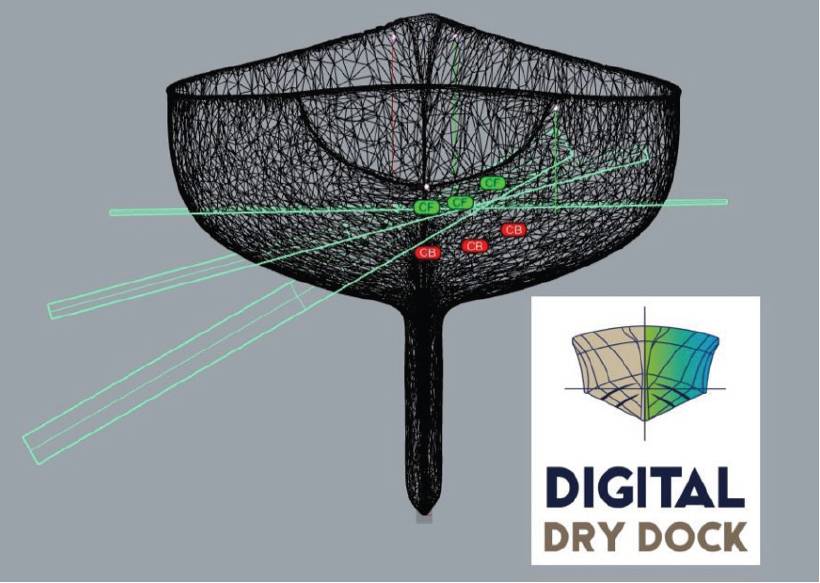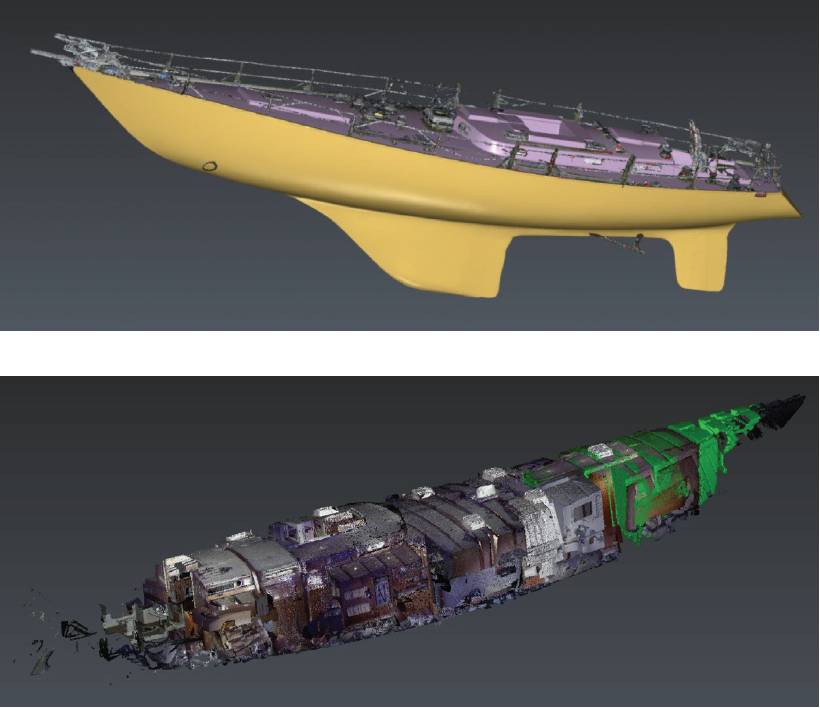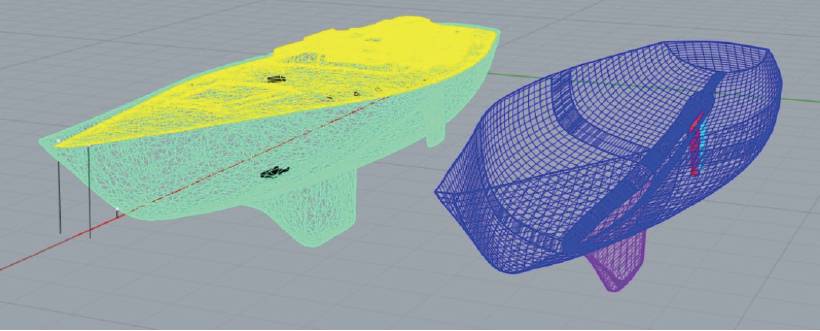Digital Dry Dock
Classic Race Yacht Performance
IMAGINE that your vessel is on charter in the Caribbean, while a European shipyard uses its digital twin to plan the next refit, or that you could start designing and building modifications to a ship before it arrives at your facility. Well, that is exactly what Digital Dry Dock is doing.

Combining naval architecture with the latest digital survey techniques, the company works across the marine sector with most of its projects centred on commercial ships and superyachts.
It has developed many robust workflows that leverage the speed of 3D laser scanning to significantly reduce project timelines and wasteful rework.
The company aims to accelerate vessel build, repair and maintenance processes to improve the quality and safety and efficiency of the global fleet.
About the project
In 2021, North Sails UK contracted Digital Dry Dock to complete a full 3D capture of a 20m classic racing yacht. The scan would capture the hull, the deck, and the interior of the vessel.
One of the reasons the scan data was required was the fact that the vessel’s original drawings could not be found, thus new measurements were needed to determine a new rig plan/sail plan and ballast configuration, as well as to satisfy the criteria needed for the vessel to achieve its Offshore Racing Congress (ORC) rating certificate.
Other uses of the new scanned data were to measure the hull shape and calculate the displacement, conduct hydrostatic analysis, measure the deck, draw sail control hardware layout, create CAD surface models of the hull to be used for CFD performance analysis, and to hold the data as a resource to draw on in future refits and performance studies. The new scans would provide accurate displacement, allowing Digital Dry Dock to create CAD surface models of the hull and appendages. North Sails Design Services Consultancy also used the models in its Hydro CFD software to conduct a performance prediction study.
Ollie Graffy, co-founder, Digital Dry Dock commented: “The constant drive for efficiency and value meant that we had to modify the way we captured the vessel data. A culture of innovation and application of the latest science and technology, use of CFD (computational fluid dynamics) required a CAD model that did not exist for this period racing yacht, and the Offshore Racing Congress allows 3D laser scan data to be used to replace conventional measurement techniques.”

Challenges
The site on which the vessel was stored was extremely busy, and the confined space of the interior made traditional measuring methods very difficult.
The site on which the vessel was stored was extremely busy, and the confined space made traditional measuring methods very difficult.Many other contractors were working in and around the vessel, thus the scan needed to be completed in a timely manner to avoid disruption to other works taking place.
Benjamin Barton, co-founder, Digital Dry Dock said: “It was necessary to coordinate with other contractors to scan with clear access. Extensive point cloud cleaning was required due to clutter and noise for the hull surface. The Leica RTC360 equipment and all the software made this job far more efficient.”
To overcome the time and space restrictions, Digital Dry Dock needed a solution that offered speed, accuracy, reliability and ease of use.
Products and implementation

Ollie Graffy and Benjamin Barton have been working in the industry all their lives.
They decided to start Digital Dry Dock in 2019 because they had both seen the potential savings that can be made by implementing new technology in the marine sector. In the early stages of the company, they have focused on investing in software (3DR, Rhino 7, Orca3D).
By utilising the option to hire the scanners, they were able to offer the latest and most appropriate hardware for the job without the nagging concerns about the capital investment whilst the technology was in its infancy.
They are now at a stage where they can begin to look at purchasing their own kit and further invest in software licences.
The scanner chosen for the project was the Leica RTC360. The 3D reality capture solution empowered Digital Dry Dock to document and capture the vessel in 3D, improving efficiency and productivity in the field and in the office through fast, simple-to-use, accurate and portable hardware and software.
The RTC360 3D laser scanner is the solution for professionals to manage project complexities with accurate and reliable 3D representations and discover the possibilities of any project.
To compliment the RTC360, Digital Dry Dock also invested in the powerful Cyclone suite of software offered by Leica Geosystems, including Field 360, Register 360 and Cyclone 3DR, as well as Publisher Pro, Enterprise, TruView, Cloudworx and Jetstream.
Leica Cyclone’s point cloud processing software provides the widest set of work process options for 3D laser scanning projects in engineering, surveying, construction and related applications.
The surveying work was complete in just one day on site whilst working around other contractors with minimal disruption.For organisations such as Digital Dry Dock that needed to add point cloud data to its process, Leica Cyclone was the solution.
It was able to create all the deliverables it needed, and served seamlessly with the RTC360. Unlike other scanning providers, the Cyclone ecosystem efficiently delivered on the entire set of project requirements, which ensured increased efficiency and profitability.
Both Ollie Graffy and Benjamin Barton also completed official training programmes with Leica Geosystems at the UK head office in Milton Keynes.
Commenting on the training Ollie Graffy said: “The Cyclone register course was really great and left us with the knowledge required to get the best out of the scanners and the software. We are also really enjoying the web-based training available on Leica My World. When we do encounter issues we cannot resolve, the live chat and email-based support has been first class.”
Benefits

Leica Geosystems scanners are easy to use, and the portability of the RTC360 was a key factor for Digital Dry Dock.
Not only was it very convenient to move around on site of the scanning project, but when the company travels internationally, it is able to take the scanner in the mission bag as carryon luggage. Moving the RTC360 around a ship is straight forward too. The lightweight carbon tripod is fast to setup and adjust.
The range and accuracy of the scanner covered most of their requirements.
Being able to check the results and coverage on-site with the Field 360 app allowed Digital Dry Dock to show initial results to the client.
Back in the office, using Reg360 with the recent updates, the team was able to decimate the point cloud on export, followed by the import of an E57 to 3DR. It found the cleaning and separation functions in 3DR to be very easy to use and fast.

Benjamin Barton said: “Next we mesh. We find the 2-steps method works really well and if we follow all the tips from the online training, we always get a great mesh to work from at the end.”
With a measuring rate of up to 2 million points per second and advanced HDR imaging system, the creation of coloured 3D point clouds can be completed in under two minutes.
The surveying work was complete in just one day on site whilst working around other contractors with minimal disruption.
Because of the speed of the scan data being captured, the deliverables were issued iteratively as each stage was completed. The entire project was tied up in just one month.
The data processing was delivered within one week after the survey was conducted.Since the introduction of the solution, Digital Dry Dock can now produce a traditional lines plan of a vessel in a day or two using this workflow, whilst it would take a traditional naval architect/ boat builder a week or more to do the same.
The data processing was delivered within one week after the survey was conducted. The company has been able to deliver over 100 digital twins in the 15 months of operation since their introduction to the RTC360 solution.
In conclusion Benjamin Barton commented: “The fact Leica products cover the whole workflow from data acquisition to processing to sharing allows us to become really familiar with the nomenclature and symbology used. The lGS, JetStream and TruView format is also a great way to share 3D data and images with our clients. Leica products make up the backbone of our company we are very impressed with the brand and the people involved. We look forward to seeing what they come up with next!”
The data processing was delivered within one week after the survey was conducted.